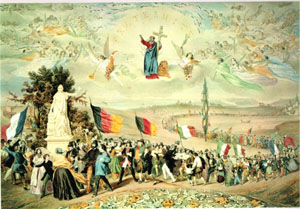4. Universal, Democratic and Social Republic: the Pact
 Click image to enlarge
Click image to enlarge
Questions
Presentation and analysis of the historical context
The victory of the Revolution of February 1848 in Paris had a contagious effect. The “Spring of Nations” questioned the Holy Alliance established at the Congress in Vienna (1815). “In March 1848, in Vienna, Berlin, Rome, Venice and Prague, insurrections break out and authoritarian rulers are forced to flee or make concessions. The pope, the King of Prussia and Bavaria and the Emperor of Austria approve constitutions and recognize the fundamental liberties. The changes are not to be avoided: while Hungary and Bohemia temporarily receive more autonomy from the Habsburgs, different regions of Germany and Italy prepare the ground for the national unity” (Mathilde Larrère). But these victories are short-lived: in France, in June, the conservative Republic crushes the hopes for a social Republic, before being overthrown in a coup on 2 December 1851. In Central Europe, the armies, loyal to the monarchist regimes (Austria-Hungary, Prussia, Russia), take advantage of the divisions among the revolutionaries to reimpose the former order: the Czech national movement is crushed in June; Vienna is taken over by force in October, the Piedmontese are defeated by the Austrians in March 1849, the parliament of Frankfurt scatters in June 1849, Hungarian patriots surrender to the Tsar’s troops in August. But repression didn’t put an end neither to liberal and national aspirations nor to social tensions (Question 1).
“Frederic Sorrieu made a series of four lithographs entitled Universal, Democratic and Social Republic, introducing the main ideas and utopias of the Forty-eighters. The Pact illustrates the nationalist dimension of the Spring of the Nations (...) In the prologue: Sorrieu presents a divine power (the angels that surround the deified Republic) scattering panic-stricken sovereigns (...) The Triumph presents the “Universal Republic” as a living goddess in a rich chariot whose reindeers are assigned to children from four continents (...) Finally, the Market depicts the utopia of abolishing all trade barriers (...) These paintings exalt the democratic and social Republic, the one that moderate republicans, electors of April, would bury with bodies of the insurgents of June 1848” (Mathilde Larrère).
The Pact presents a procession of European nations under the leadership of France. The crowd in which people of all genders, ages and social classes mingle, pass before a tree of freedom before getting together at the foot of an allegorical statue of the Republic which is erected in front of an oak. The nations are recognizable by their flags (French, German, Italian, Hungarian, and Czech) and by their traditional dresses. The author, though an internationalist, produced a work to the glory of France: the Republic has the universal features of Marianne and a fleet of tricolor flags leads the procession. The decline of monarchs is symbolized by royal attributes which are strewn on the ground. In the sky, Christ surrounded by angels and republican martyrs gives his blessing to the crowd. At his feet, there is a lion symbolizing force. Brotherhood, both Christian and republican, joins nations and people of different classes, except the aristocracy. The the dream of the Universal Republic, according to its designers (among them Victor Hugo), has to be linked with the call for the “United States of Europe” that alone can guarantee peace and brotherhood among peoples (Question 2).
Faced with the “Holy Alliance” of authoritarian monarchs, the author advocates an alliance of peoples and nations as a part of the Universal Republic which blends Christianity with the ideals of the French Revolution (Question 3).
Links
http://www.histoireimage.org/site/etude_comp/etude_comp_detail.php?i=80&d=1&a=92&id_sel=16 Mathilde Larrère, on “1789-1939: History through Images” website (Meeting of the National Museums and Heritage Directorate), published a file on the “Republican Utopianism of 1848” based on four lithographs of Frederique Sorrieu entitled “The Universal Democratic and Social Republic.”



